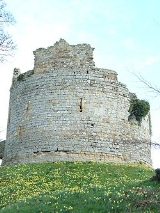
Hawarden Castle
Encyclopedia
Hawarden Old Castle is a medieval castle
near Hawarden
, Flintshire
, Wales
.
Its oldest origins are indeterminate and the oldest fortifications on this site may date back to the Iron Age
, later being used as a Norman
Motte-and-bailey
castle which was reportedly destroyed and replaced in a short period during the 13th century.
The castle played an important role during the Welsh
struggle for independence in the 13th century. At Easter 1282, Dafydd ap Gruffudd attacked Hawarden Castle, thereby starting the final Welsh conflict with Norman England, in the course of which Welsh independence was lost. King Edward I
's sense of outrage was such that he designed a punishment for Dafydd harsher than any previous form of capital punishment; Dafydd was hanged, drawn, and quartered in Shrewsbury in October 1283. In 1294 the castle was captured during the revolt of Madog ap Llywelyn
.
After the English Civil War
in the 17th century the castle was slighted
on the orders of Oliver Cromwell
. Its ruins are on the New Hawarden Castle estate
and are open to the public on some Sundays, typically the second and fourth Sundays in summertime.
Castle
A castle is a type of fortified structure built in Europe and the Middle East during the Middle Ages by European nobility. Scholars debate the scope of the word castle, but usually consider it to be the private fortified residence of a lord or noble...
near Hawarden
Hawarden
Hawarden is a village in Flintshire, North Wales. Hawarden forms part of the Deeside conurbation on the Welsh/English border. At the 2001 Census, the population of Hawarden Ward was 1,858...
, Flintshire
Flintshire
Flintshire is a county in north-east Wales. It borders Denbighshire, Wrexham and the English county of Cheshire. It is named after the historic county of Flintshire, which had notably different borders...
, Wales
Wales
Wales is a country that is part of the United Kingdom and the island of Great Britain, bordered by England to its east and the Atlantic Ocean and Irish Sea to its west. It has a population of three million, and a total area of 20,779 km²...
.
Its oldest origins are indeterminate and the oldest fortifications on this site may date back to the Iron Age
Iron Age
The Iron Age is the archaeological period generally occurring after the Bronze Age, marked by the prevalent use of iron. The early period of the age is characterized by the widespread use of iron or steel. The adoption of such material coincided with other changes in society, including differing...
, later being used as a Norman
Norman architecture
About|Romanesque architecture, primarily English|other buildings in Normandy|Architecture of Normandy.File:Durham Cathedral. Nave by James Valentine c.1890.jpg|thumb|200px|The nave of Durham Cathedral demonstrates the characteristic round arched style, though use of shallow pointed arches above the...
Motte-and-bailey
Motte-and-bailey
A motte-and-bailey is a form of castle, with a wooden or stone keep situated on a raised earthwork called a motte, accompanied by an enclosed courtyard, or bailey, surrounded by a protective ditch and palisade...
castle which was reportedly destroyed and replaced in a short period during the 13th century.
The castle played an important role during the Welsh
Wales
Wales is a country that is part of the United Kingdom and the island of Great Britain, bordered by England to its east and the Atlantic Ocean and Irish Sea to its west. It has a population of three million, and a total area of 20,779 km²...
struggle for independence in the 13th century. At Easter 1282, Dafydd ap Gruffudd attacked Hawarden Castle, thereby starting the final Welsh conflict with Norman England, in the course of which Welsh independence was lost. King Edward I
Edward I of England
Edward I , also known as Edward Longshanks and the Hammer of the Scots, was King of England from 1272 to 1307. The first son of Henry III, Edward was involved early in the political intrigues of his father's reign, which included an outright rebellion by the English barons...
's sense of outrage was such that he designed a punishment for Dafydd harsher than any previous form of capital punishment; Dafydd was hanged, drawn, and quartered in Shrewsbury in October 1283. In 1294 the castle was captured during the revolt of Madog ap Llywelyn
Madog ap Llywelyn
Madog ap Llywelyn, or Prince Madoc, was from a junior branch of the House of Aberffraw and a distant relation of Llywelyn ap Gruffudd, the last recognised native Prince of Wales.-Lineage:...
.
After the English Civil War
English Civil War
The English Civil War was a series of armed conflicts and political machinations between Parliamentarians and Royalists...
in the 17th century the castle was slighted
Slighting
A slighting is the deliberate destruction, partial or complete, of a fortification without opposition. During the English Civil War this was to render it unusable as a fort.-Middle Ages:...
on the orders of Oliver Cromwell
Oliver Cromwell
Oliver Cromwell was an English military and political leader who overthrew the English monarchy and temporarily turned England into a republican Commonwealth, and served as Lord Protector of England, Scotland, and Ireland....
. Its ruins are on the New Hawarden Castle estate
Hawarden Castle (18th century)
New Hawarden Castle, in Hawarden, Flintshire, Wales was the estate of former British Prime Minister William Ewart Gladstone, which previously belonged to the family of his wife, Catherine Glynne. It was built in 1752...
and are open to the public on some Sundays, typically the second and fourth Sundays in summertime.

